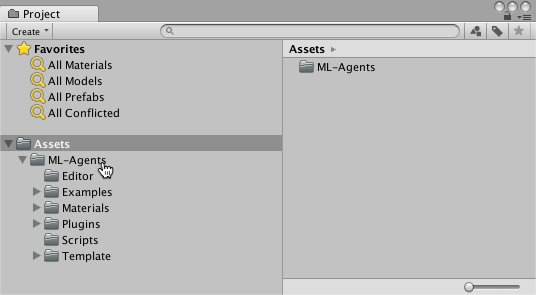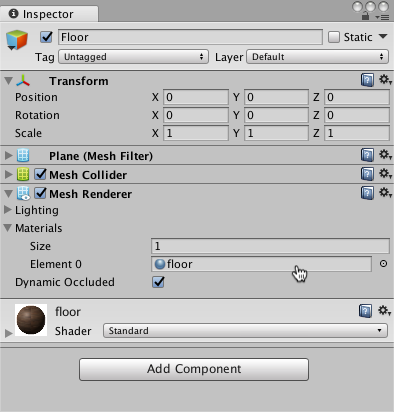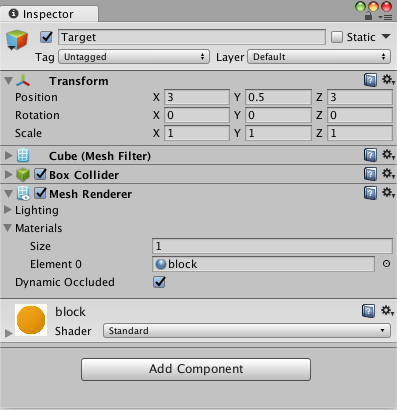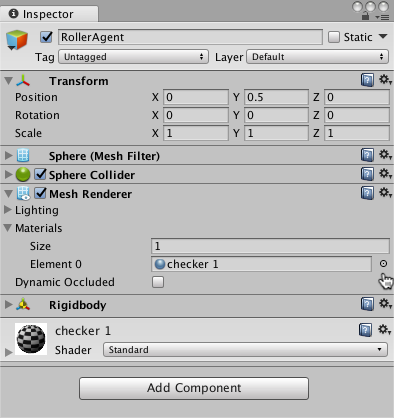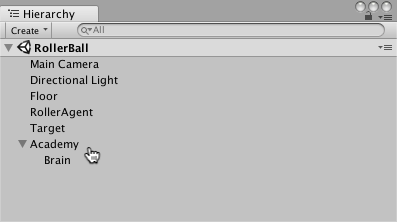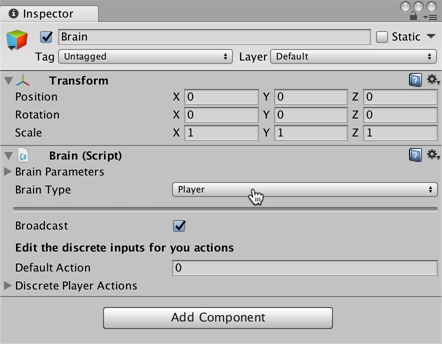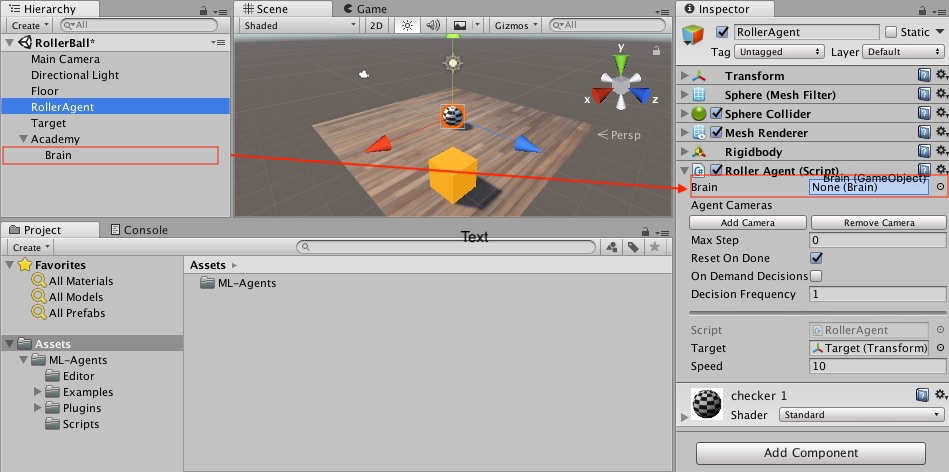22 KiB
Making a new Learning Environment
This tutorial walks through the process of creating a Unity Environment. A Unity Environment is an application built using the Unity Engine which can be used to train Reinforcement Learning agents.
In this example, we will train a ball to roll to a randomly placed cube. The ball also learns to avoid falling off the platform.
Overview
Using ML-Agents in a Unity project involves the following basic steps:
- Create an environment for your agents to live in. An environment can range from a simple physical simulation containing a few objects to an entire game or ecosystem.
- Implement an Academy subclass and add it to a GameObject in the Unity scene containing the environment. This GameObject will serve as the parent for any Brain objects in the scene. Your Academy class can implement a few optional methods to update the scene independently of any agents. For example, you can add, move, or delete agents and other entities in the environment.
- Add one or more Brain objects to the scene as children of the Academy.
- Implement your Agent subclasses. An Agent subclass defines the code an agent uses to observe its environment, to carry out assigned actions, and to calculate the rewards used for reinforcement training. You can also implement optional methods to reset the agent when it has finished or failed its task.
- Add your Agent subclasses to appropriate GameObjects, typically, the object in the scene that represents the agent in the simulation. Each Agent object must be assigned a Brain object.
- If training, set the Brain type to External and run the training process.
Note: If you are unfamiliar with Unity, refer to Learning the interface in the Unity Manual if an Editor task isn't explained sufficiently in this tutorial.
If you haven't already, follow the installation instructions.
Set Up the Unity Project
The first task to accomplish is simply creating a new Unity project and importing the ML-Agents assets into it:
-
Launch the Unity Editor and create a new project named "RollerBall".
-
In a file system window, navigate to the folder containing your cloned ML-Agents repository.
-
Drag the
ML-Agentsfolder fromunity-environments/Assetsto the Unity Editor Project window.
Your Unity Project window should contain the following assets:
Create the Environment:
Next, we will create a very simple scene to act as our ML-Agents environment. The "physical" components of the environment include a Plane to act as the floor for the agent to move around on, a Cube to act as the goal or target for the agent to seek, and a Sphere to represent the agent itself.
Create the floor plane:
- Right click in Hierarchy window, select 3D Object > Plane.
- Name the GameObject "Floor."
- Select Plane to view its properties in the Inspector window.
- Set Transform to Position = (0,0,0), Rotation = (0,0,0), Scale = (1,1,1).
- On the Plane's Mesh Renderer, expand the Materials property and change the default-material to floor.
(To set a new material, click the small circle icon next to the current material name. This opens the Object Picker dialog so that you can choose the a different material from the list of all materials currently in the project.)
Add the Target Cube
- Right click in Hierarchy window, select 3D Object > Cube.
- Name the GameObject "Target"
- Select Target to view its properties in the Inspector window.
- Set Transform to Position = (3,0.5,3), Rotation = (0,0,0), Scale = (1,1,1).
- On the Cube's Mesh Renderer, expand the Materials property and change the default-material to block.
Add the Agent Sphere
- Right click in Hierarchy window, select 3D Object > Sphere.
- Name the GameObject "RollerAgent"
- Select Target to view its properties in the Inspector window.
- Set Transform to Position = (0,0.5,0), Rotation = (0,0,0), Scale = (1,1,1).
- On the Sphere's Mesh Renderer, expand the Materials property and change the default-material to checker 1.
- Click Add Component.
- Add the Physics/Rigidbody component to the Sphere. (Adding a Rigidbody )
Note that we will create an Agent subclass to add to this GameObject as a component later in the tutorial.
Add Empty GameObjects to Hold the Academy and Brain
- Right click in Hierarchy window, select Create Empty.
- Name the GameObject "Academy"
- Right-click on the Academy GameObject and select Create Empty.
- Name this child of the Academy, "Brain".
You can adjust the camera angles to give a better view of the scene at runtime. The next steps will be to create and add the ML-Agent components.
Implement an Academy
The Academy object coordinates the ML-Agents in the scene and drives the decision-making portion of the simulation loop. Every ML-Agent scene needs one Academy instance. Since the base Academy classis abstract, you must make your own subclass even if you don't need to use any of the methods for a particular environment.
First, add a New Script component to the Academy GameObject created earlier:
- Select the Academy GameObject to view it in the Inspector window.
- Click Add Component.
- Click New Script in the list of components (at the bottom).
- Name the script "RollerAcademy".
- Click Create and Add.
Next, edit the new RollerAcademy script:
- In the Unity Project window, double-click the
RollerAcademyscript to open it in your code editor. (By default new scripts are placed directly in the Assets folder.) - In the editor, change the base class from
MonoBehaviourtoAcademy. - Delete the
Start()andUpdate()methods that were added by default.
In such a basic scene, we don't need the Academy to initialize, reset, or otherwise control any objects in the environment so we have the simplest possible Academy implementation:
public class RollerAcademy : Academy { }
The default settings for the Academy properties are also fine for this environment, so we don't need to change anything for the RollerAcademy component in the Inspector window.
Add a Brain
The Brain object encapsulates the decision making process. An Agent sends its observations to its Brain and expects a decision in return. The Brain Type setting determines how the Brain makes decisions. Unlike the Academy and Agent classes, you don't make your own Brain subclasses. (You can extend CoreBrain to make your own types of Brain, but the four built-in brain types should cover almost all scenarios.)
To create the Brain:
- Right-click the Academy GameObject in the Hierarchy window and choose Create Empty to add a child GameObject.
- Name the new GameObject, "Brain".
- Select the Brain GameObject to show its properties in the Inspector window.
- Click Add Component.
- Select the Scripts/Brain component to add it to the GameObject.
We will come back to the Brain properties later, but leave the Brain Type as Player for now.
Implement an Agent
To create the Agent:
- Select the RollerAgent GameObject to view it in the Inspector window.
- Click Add Component.
- Click New Script in the list of components (at the bottom).
- Name the script "RollerAgent".
- Click Create and Add.
Then, edit the new RollerAgent script:
- In the Unity Project window, double-click the
RollerAgentscript to open it in your code editor. - In the editor, change the base class from
MonoBehaviourtoAgent. - Delete the
Update()method, but we will use theStart()function, so leave it alone for now.
So far, these are the basic steps that you would use to add ML-Agents to any Unity project. Next, we will add the logic that will let our agent learn to roll to the cube.
In this simple scenario, we don't use the Academy object to control the environment. If we wanted to change the environment, for example change the size of the floor or add or remove agents or other objects before or during the simulation, we could implement the appropriate methods in the Academy. Instead, we will have the Agent do all the work of resetting itself and the target when it succeeds or falls trying.
Initialization and Resetting the Agent
When the agent reaches its target, it marks itself done and its agent reset function moves the target to a random location. In addition, if the agent rolls off the platform, the reset function puts it back onto the floor.
To move the target GameObject, we need a reference to its Transform (which stores a GameObject's position, orientation and scale in the 3D world). To get this reference, add a public field of type Transform to the RollerAgent class. Public fields of a component in Unity get displayed in the Inspector window, allowing you to choose which GameObject to use as the target in the Unity Editor. To reset the agent's velocity (and later to apply force to move the agent) we need a reference to the Rigidbody component. A Rigidbody is Unity's primary element for physics simulation. (See Physics for full documentation of Unity physics.) Since the Rigidbody component is on the same GameObject as our Agent script, the best way to get this reference is using GameObject.GetComponent<T>(), which we can call in our script's Start() method.
So far, our RollerAgent script looks like:
using System.Collections.Generic;
using UnityEngine;
public class RollerAgent : Agent
{
Rigidbody rBody;
void Start () {
rBody = GetComponent<Rigidbody>();
}
public Transform Target;
public override void AgentReset()
{
if (this.transform.position.y < -1.0)
{
// The agent fell
this.transform.position = Vector3.zero;
this.rBody.angularVelocity = Vector3.zero;
this.rBody.velocity = Vector3.zero;
}
else
{
// Move the target to a new spot
Target.position = new Vector3(Random.value * 8 - 4,
0.5f,
Random.value * 8 - 4);
}
}
}
Next, let's implement the Agent.CollectObservations() function.
Observing the Environment
The Agent sends the information we collect to the Brain, which uses it to make a decision. When you train the agent using the PPO training algorithm (or use a trained PPO model), the data is fed into a neural network as a feature vector. For an agent to successfully learn a task, we need to provide the correct information. A good rule of thumb for deciding what information to collect is to consider what you would need to calculate an analytical solution to the problem.
In our case, the information our agent collects includes:
-
Position of the target. In general, it is better to use the relative position of other objects rather than the absolute position for more generalizable training. Note that the agent only collects the x and z coordinates since the floor is aligned with the xz plane and the y component of the target's position never changes.
// Calculate relative position Vector3 relativePosition = Target.position - this.transform.position; // Relative position AddVectorObs(relativePosition.x/5); AddVectorObs(relativePosition.z/5); -
Position of the agent itself within the confines of the floor. This data is collected as the agent's distance from each edge of the floor.
// Distance to edges of platform AddVectorObs((this.transform.position.x + 5) / 5); AddVectorObs((this.transform.position.x - 5) / 5); AddVectorObs((this.transform.position.z + 5) / 5); AddVectorObs((this.transform.position.z - 5) / 5); -
The velocity of the agent. This helps the agent learn to control its speed so it doesn't overshoot the target and roll off the platform.
// Agent velocity AddVectorObs(rBody.velocity.x/5); AddVectorObs(rBody.velocity.z/5);
All the values are divided by 5 to normalize the inputs to the neural network to the range [-1,1]. (The number five is used because the platform is 10 units across.)
In total, the state observation contains 8 values and we need to use the continuous state space when we get around to setting the Brain properties:
List<float> observation = new List<float>();
public override void CollectObservations()
{
// Calculate relative position
Vector3 relativePosition = Target.position - this.transform.position;
// Relative position
AddVectorObs(relativePosition.x/5);
AddVectorObs(relativePosition.z/5);
// Distance to edges of platform
AddVectorObs((this.transform.position.x + 5)/5);
AddVectorObs((this.transform.position.x - 5)/5);
AddVectorObs((this.transform.position.z + 5)/5);
AddVectorObs((this.transform.position.z - 5)/5);
// Agent velocity
AddVectorObs(rBody.velocity.x/5);
AddVectorObs(rBody.velocity.z/5);
}
The final part of the Agent code is the Agent.AgentAct() function, which receives the decision from the Brain.
Actions
The decision of the Brain comes in the form of an action array passed to the AgentAct() function. The number of elements in this array is determined by the Vector Action Space Type and Vector Action Space Size settings of the agent's Brain. The RollerAgent uses the continuous vector action space and needs two continuous control signals from the brain. Thus, we will set the Brain Vector Action Size to 2. The first element,action[0] determines the force applied along the x axis; action[1] determines the force applied along the z axis. (If we allowed the agent to move in three dimensions, then we would need to set Vector Action Size to 3. Note the Brain really has no idea what the values in the action array mean. The training process adjust the action values in response to the observation input and then sees what kind of rewards it gets as a result.
Before we can add a force to the agent, we need a reference to its Rigidbody component. A Rigidbody is Unity's primary element for physics simulation. (See Physics for full documentation of Unity physics.) A good place to set references to other components of the same GameObject is in the standard Unity Start() method:
With the reference to the Rigidbody, the agent can apply the values from the action[] array using the Rigidbody.AddForce function:
Vector3 controlSignal = Vector3.zero;
controlSignal.x = Mathf.Clamp(action[0], -1, 1);
controlSignal.z = Mathf.Clamp(action[1], -1, 1);
rBody.AddForce(controlSignal * speed);
The agent clamps the action values to the range [-1,1] for two reasons. First, the learning algorithm has less incentive to try very large values (since there won't be any affect on agent behavior), which can avoid numeric instability in the neural network calculations. Second, nothing prevents the neural network from returning excessively large values, so we want to limit them to reasonable ranges in any case.
Rewards
Rewards are also assigned in the AgentAct() function. The learning algorithm uses the rewards assigned to the agent property at each step in the simulation and learning process to determine whether it is giving the agent to optimal actions. You want to reward an agent for completing the assigned task (reaching the Target cube, in this case) and punish the agent if it irrevocably fails (falls off the platform). You can sometimes speed up training with sub-rewards that encourage behavior that helps the agent complete the task. For example, the RollerAgent reward system provides a small reward if the agent moves closer to the target in a step.
The RollerAgent calculates the distance to detect when it reaches the target. When it does, the code increments the Agent.reward variable by 1.0 and marks the agent as finished by setting the agent to done.
float distanceToTarget = Vector3.Distance(this.transform.position,
Target.position);
// Reached target
if (distanceToTarget < 1.42f)
{
Done();
AddReward(1.0f);
}
Note: When you mark an agent as done, it stops its activity until it is reset. You can have the agent reset immediately, by setting the Agent.ResetOnDone property in the inspector or you can wait for the Academy to reset the environment. This RollerBall environment relies on the ResetOnDone mechanism and doesn't set a Max Steps limit for the Academy (so it never resets the environment).
To encourage the agent along, we also reward it for getting closer to the target (saving the previous distance measurement between steps):
// Getting closer
if (distanceToTarget < previousDistance)
{
AddReward(0.1f);
}
It can also encourage an agent to finish a task more quickly to assign a negative reward at each step:
// Time penalty
AddReward(-0.05f);
Finally, to punish the agent for falling off the platform, assign a large negative reward and, of course, set the agent to done so that it resets itself in the next step:
// Fell off platform
if (this.transform.position.y < -1.0)
{
Done();
AddReward(-1.0f);
}
AgentAct()
With the action and reward logic outlined above, the final version of the AgentAct() function looks like:
public float speed = 10;
private float previousDistance = float.MaxValue;
public override void AgentAct(float[] action)
{
// Rewards
float distanceToTarget = Vector3.Distance(this.transform.position,
Target.position);
// Reached target
if (distanceToTarget < 1.42f)
{
Done();
AddReward(1.0f);
}
// Getting closer
if (distanceToTarget < previousDistance)
{
AddReward(0.1f);
}
// Time penalty
AddReward(-0.05f);
// Fell off platform
if (this.transform.position.y < -1.0)
{
Done();
AddReward(-1.0f);
}
previousDistance = distanceToTarget;
// Actions, size = 2
Vector3 controlSignal = Vector3.zero;
controlSignal.x = Mathf.Clamp(action[0], -1, 1);
controlSignal.z = Mathf.Clamp(action[1], -1, 1);
rBody.AddForce(controlSignal * speed);
}
Note the speed and previousDistance class variables defined before the function. Since speed is public, you can set the value from the Inspector window.
Final Editor Setup
Now, that all the GameObjects and ML-Agent components are in place, it is time to connect everything together in the Unity Editor. This involves assigning the Brain object to the Agent and setting the Brain properties so that they are compatible with our agent code.
- Expand the Academy GameObject in the Hierarchy window, so that the Brain object is visible.
- Select the RollerAgent GameObject to show its properties in the Inspector window.
- Drag the Brain object from the Hierarchy window to the RollerAgent Brain field.
Also, drag the Target GameObject from the Hierarchy window to the RollerAgent Target field.
Finally, select the Brain GameObject so that you can see its properties in the Inspector window. Set the following properties:
Vector Observation Space Size= 8Vector Action Space Size= 2Vector Action Space Type= ContinuousVector Observation Space Type= ContinuousBrain Type= Player
Now you are ready to test the environment before training.
Testing the Environment
It is always a good idea to test your environment manually before embarking on an extended training run. The reason we have left the Brain set to the Player type is so that we can control the agent using direct keyboard control. But first, you need to define the keyboard to action mapping. Although the RollerAgent only has an Action Size of two, we will use one key to specify positive values and one to specify negative values for each action, for a total of four keys.
- Select the Brain GameObject to view its properties in the Inspector.
- Set Brain Type to Player.
- Expand the Continuous Player Actions dictionary (only visible when using the *Player brain).
- Set Size to 4.
- Set the following mappings:
| Element | Key | Index | Value |
|---|---|---|---|
| Element 0 | D | 0 | 1 |
| Element 1 | A | 0 | -1 |
| Element 2 | W | 1 | 1 |
| Element 3 | S | 1 | -1 |
The Index value corresponds to the index of the action array passed to AgentAct() function. Value is assigned to action[Index] when Key is pressed.
Press Play to run the scene and use the WASD keys to move the agent around the platform. Make sure that there are no errors displayed in the Unity editor Console window and that the agent resets when it reaches its target or falls from the platform. Note that for more involved debugging, the ML-Agents SDK includes a convenient Monitor class that you can use to easily display agent status information in the Game window.
Now you can train the Agent. To get ready for training, you must first to change the Brain Type from Player to External. From there the process is the same as described in Getting Started with the 3D Balance Ball Environment.

